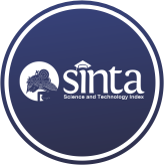Analisis Performa Raytracing dan MCMC Pada Realisme Visualisasi Obyek 3D Dengan Terintegrasi MIPMapping
(1) Universitas Kristen Immanuel, Yogyakarta, Indonesia
(2) Universitas Kristen Immanuel, Yogyakarta, Indonesia
(3) Universitas Kristen Immanuel, Yogyakarta, Indonesia
(*) Corresponding Author
Abstract
Full Text:
PDFReferences
I. N. B. Hartawan and A. M. Dirgayusari, “Analisis Rendering Video Animasi 3D Menggunakan Aplikasi Blender Berbasis Network Render,” J. Resist. (Rekayasa Sist. Komputer), vol. 1, no. 1, pp. 25–33, 2020, doi: 10.31598/jurnalresistor.v1i1.223.
B. E. Tarazona-Romero, N. Y. Castillo Leon, J. G. Ascanio Villabona, M. A. Duran Sarmiento, P. Hulse, and C. G. Cardenas Arias, “Performance evaluation of a parabolic cylinder collector applying the Monte Carlo ray tracing method,” Sustain. Eng. Innov., vol. 6, no. 1, pp. 3–16, 2024, doi: 10.37868/sei.v6i1.id226.
A. Keller, C. Wächter, and N. Binder, “Quasi-Monte Carlo Algorithms (not only) for Graphics Software,” pp. 1–18, 2023, [Online]. Available: http://arxiv.org/abs/2307.15584
M. Ula, “Realistic Texturing pada Objek 3-dimensi Menggunakan Model Tehnik Texture Mapping,” J. Arsitekno, vol. 6, no. 6, p. 12, 2021, doi: 10.29103/arj.v6i6.1217.
I. Wald, “Realtime Ray Tracing and Interactive Global Illumination,” IT - Inf.
Technol., vol. 48, no. 4, pp. 242–245, 2020, doi: 10.1524/itit.2006.48.4.242.
R. W. Jens Krüger, “‘Efficient Ray Tracing of Volume Data Using Multi- Dimensional MIP Mapping,’” IEEE Trans. Vis. Comput. Graph., vol. 4, pp. 147– 173, 2023.
R. Ghaffari, P. Abdi, A. Moghaddasi, S. Heidarzadeh, H. Ghahvhechian, and M. Kasiri, “Ray Tracing versus Thin-Lens Formulas for IOL Power Calculation Using Swept-Source Optical Coherence Tomography Biometry,” J. Ophthalmic Vis. Res., vol. 17, no. 2, pp. 176–185, 2022, doi: 10.18502/jovr.v17i2.10788.
N. I. Ziedan, “Urban positioning accuracy enhancement utilizing 3D buildings model and accelerated ray tracing algorithm,” 30th Int. Tech. Meet. Satell. Div. Inst. Navig. ION GNSS 2017, vol. 5, no. September, pp. 3253–3268, 2017, doi: 10.33012/2017.15366.
V. Giangaspero, V. Sharma, J. Laur, J. Thoemel, S. Poedts, and A. Lani, “Ray Tracing Analysis of High Frequency Communication System in Inductively Coupled Plasma Facility,” 2022, doi: 10.13009/EUCASS2022-6181.
N. Hikmah, M. Fachri, and R. Darmawan, “Visualization of Real-World 3D Reconstructed Objects with Real-Time Ray Tracing on Ampere Architecture Graphic Processing Unit,” vol. 5, no. 36, pp. 2039–2045, 2021.
M. A. Bin Misran, A. Bilgaiyan, and R. Hattori, “Optical Ray Tracing Simulation by Using Monte Carlo Method for Reflectance-based Photoplethysmography Sensor in Human Skin and Fingertip Model,” Comput. Exp. Res. Mater. Renew. Energy, vol. 5, no. 2, p. 78, 2022, doi: 10.19184/cerimre.v5i2.31668.
M. I. Disney, P. Lewis, and P. R. J. North, “Monte Carlo ray tracing in optical canopy reflectance modelling,” Remote Sens. Rev., vol. 18, no. 2, pp. 163–196, 2020, doi: 10.1080/02757250009532389.
M. A. Bin Misran, A. Bilgaiyan, and R. Hattori, “Optical Ray Tracing Simulation by Using Monte Carlo Method for Reflectance-based Photoplethysmography Sensor in Human Skin and Fingertip Model,” Comput. Exp. Res. Mater. Renew. Energy, vol. 5, no. 2, p. 78, 2022, doi: 10.19184/cerimre.v5i2.31668.
O. González, S. Rodríguez, R. Pérez-Jiménez, B. R. Mendoza, and A. Ayala,
“Comparison of Monte Carlo ray-tracing and photon-tracing methods for calculation of the impulse response on indoor wireless optical channels,” Opt. Express, vol. 19, no. 3, p. 1997, 2021, doi: 10.1364/oe.19.001997.
P. Mykhaylov, R. Y. Chekhmestruk, O. N. Romanyuk, and S. V. Kotlyk, “MIP mapping the virtual environment for computer games,” Autom. Technol. Bus. Process., vol. 13, no. 4, pp. 34–39, 2022, doi: 10.15673/atbp.v13i4.2220.
W. C. Park, D. S. Kim, J. S. Park, S. D. Kim, H. S. Kim, and T. D. Han, “The design of a texture mapping unit with effective MIP-map level selection for real- time ray tracing,” IEICE Electron. Express, vol. 8, no. 13, pp. 1064–1070, 2021, doi: 10.1587/elex.8.1064.
R. Humayrah, A. M. Elhanafi, and M. T. Batubara, “Analisa Histogram dan PSNR Pada Citra True Color Dalam Pengamanan Teks Menggunakan Spread Spectrum dan LSB Histogram and PSNR Analysis on True Color Image in Text Security Using Spread Spectrum and LSB,” J. Ilmu Komput. dan Sist. Inf., vol. 2, no. 1, pp. 188–200, 2022.
H. Sajati, “The Effect of Peak Signal to Noise Ratio (PSNR) Values on Object Detection Accuracy in Viola Jones Method,” Conf. Senat. STT Adisutjipto Yogyakarta, vol. 4, 2022, doi: 10.28989/senatik.v4i0.139.
U. Sara, M. Akter, and M. S. Uddin, “Image Quality Assessment through FSIM, SSIM, MSE and PSNR—A Comparative Study,” J. Comput. Commun., vol. 07, no. 03, pp. 8–18, 2020, doi: 10.4236/jcc.2019.73002.
V. I. Ungureanu, P. Negirla, and A. Korodi, “Image-Compression Techniques: Classical and ‘Region-of-Interest-Based’ Approaches Presented in Recent Papers,” Sensors, vol. 24, no. 3, 2024, doi: 10.3390/s24030791.
DOI: https://doi.org/10.30645/kesatria.v5i3.436
DOI (PDF): https://doi.org/10.30645/kesatria.v5i3.436.g431
Refbacks
- There are currently no refbacks.
Published Papers Indexed/Abstracted By:














